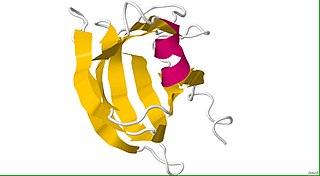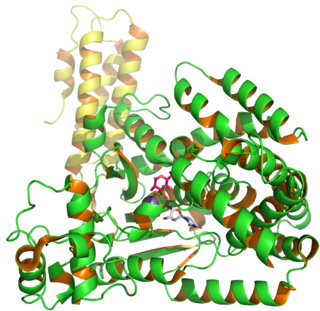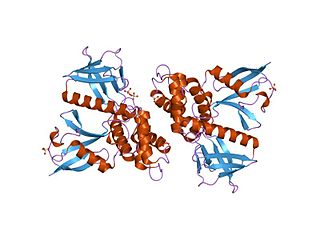
Adenylyl cyclase is an enzyme with key regulatory roles in essentially all cells. It is the most polyphyletic known enzyme: six distinct classes have been described, all catalyzing the same reaction but representing unrelated gene families with no known sequence or structural homology. The best known class of adenylyl cyclases is class III or AC-III. AC-III occurs widely in eukaryotes and has important roles in many human tissues.
GTPases are a large family of hydrolase enzymes that bind to the nucleotide guanosine triphosphate (GTP) and hydrolyze it to guanosine diphosphate (GDP). The GTP binding and hydrolysis takes place in the highly conserved G domain common to many GTPases.
Virulence factors are cellular structures, molecules and regulatory systems that enable microbial pathogens to achieve the following:
Adenylate cyclase toxin is a virulence factor produced by some members of the genus Bordetella. Together with the pertussis toxin it is the most important virulence factor of the causative agent of whooping cough, Bordetella pertussis. Bordetella bronchiseptica and Bordetella parapertussis, also able to cause pertussis-like symptoms, also produce adenylate cyclase toxin. It is a toxin secreted by the bacteria to influence the host immune system.

EF-Tu is a prokaryotic elongation factor responsible for catalyzing the binding of an aminoacyl-tRNA (aa-tRNA) to the ribosome. It is a G-protein, and facilitates the selection and binding of an aa-tRNA to the A-site of the ribosome. As a reflection of its crucial role in translation, EF-Tu is one of the most abundant and highly conserved proteins in prokaryotes. It is found in eukaryotic mitochrondria as TUFM.
The AB5 toxins are six-component protein complexes secreted by certain pathogenic bacteria known to cause human diseases such as cholera, dysentery, and hemolytic–uremic syndrome. One component is known as the A subunit, and the remaining five components are B subunits. All of these toxins share a similar structure and mechanism for entering targeted host cells. The B subunit is responsible for binding to receptors to open up a pathway for the A subunit to enter the cell. The A subunit is then able to use its catalytic machinery to take over the host cell's regular functions.
Tir is an essential component in the adherence of the enteropathogenic Escherichia coli (EPEC) and enterohemorraghic Escherichia coli (EHEC) to the cells lining the small intestine. To aid attachment, both EPEC and EHEC possess the ability to reorganise the host cell actin cytoskeleton via the secretion of virulence factors. These factors are secreted directly into the cells using a Type three secretion system. One of the virulence factors secreted is the Translocated Intimin Receptor (Tir). Tir is a receptor protein encoded by the espE gene which is located on the locus of enterocyte effacement (LEE) pathogenicity island in EPEC strains. It is secreted into the host cell membranes and acts as a receptor for intimin which is found on the bacterial surface. Once Tir binds intimin, the bacterium is attached to the enterocyte surface.
G12/G13 alpha subunits are alpha subunits of heterotrimeric G proteins that link cell surface G protein-coupled receptors primarily to guanine nucleotide exchange factors for the Rho small GTPases to regulate the actin cytoskeleton. Together, these two proteins comprise one of the four classes of G protein alpha subunits. G protein alpha subunits bind to guanine nucleotides and function in a regulatory cycle, and are active when bound to GTP but inactive and associated with the G beta-gamma complex when bound to GDP. G12/G13 are not targets of pertussis toxin or cholera toxin, as are other classes of G protein alpha subunits.

Transforming protein RhoA, also known as Ras homolog family member A (RhoA), is a small GTPase protein in the Rho family of GTPases that in humans is encoded by the RHOA gene. While the effects of RhoA activity are not all well known, it is primarily associated with cytoskeleton regulation, mostly actin stress fibers formation and actomyosin contractility. It acts upon several effectors. Among them, ROCK1 and DIAPH1 are the best described. RhoA, and the other Rho GTPases, are part of a larger family of related proteins known as the Ras superfamily, a family of proteins involved in the regulation and timing of cell division. RhoA is one of the oldest Rho GTPases, with homologues present in the genomes since 1.5 billion years. As a consequence, RhoA is somehow involved in many cellular processes which emerged throughout evolution. RhoA specifically is regarded as a prominent regulatory factor in other functions such as the regulation of cytoskeletal dynamics, transcription, cell cycle progression and cell transformation.
Membrane ruffling (also known as cell ruffling) is the formation of a motile cell surface that contains a meshwork of newly polymerized actin filaments. It can also be regarded as one of the earliest structural changes observed in the cell. The GTP-binding protein Rac is the regulator of this membrane ruffling. Changes in the Polyphosphoinositide metabolism and changes in Ca2+ level of the cell may also play an important role. A number of actin-binding and organizing proteins localize to membrane ruffles and potentially target to transducing molecules.

Clostridium enterotoxins are toxins produced by Clostridium species.

Clostridium difficile toxin B is a cytotoxin produced by the bacteria Clostridioides difficile, formerly known as Clostridium difficile. It is one of two major kinds of toxins produced by C. difficile , the other being an enterotoxin. Both are very potent and lethal.

Clostridium difficile toxin A (TcdA) is a toxin generated by Clostridioides difficile, formerly known as Clostridium difficile. It is similar to Clostridium difficile Toxin B. The toxins are the main virulence factors produced by the gram positive, anaerobic, Clostridioides difficile bacteria. The toxins function by damaging the intestinal mucosa and cause the symptoms of C. difficile infection, including pseudomembranous colitis.
Clostridium novyi (oedematiens) a Gram-positive, endospore- forming, obligate anaerobic bacteria of the class clostridia. It is ubiquitous, being found in the soil and faeces. It is pathogenic, causing a wide variety of diseases in man and animals. It comes in three types, labelled A, B, and a non-pathogenic type C distinguished by the range of toxins they produce. Some authors include Clostridium haemolyticum as Clostridium novyi type D. C novyi is closely related to Clostridium botulinum types C and D as Yoshimasa Sasaki et al. have demonstrated by 16S rDNA sequence analysis.
Serotonylation is a receptor independent signaling mechanism by which serotonin activates intracellular processes by creating long lasting covalent bonds upon proteins. It occurs through the modification of proteins by the attachment of serotonin on their glutamine residues. This happens through the enzyme transglutaminase and the creation of glutamyl-amide bonds. This process occurs following serotonin transportation into the cell rather on plasma membranes as with the brief interactions that serotonin has when it activates 5-HT receptors.
The RTX toxin superfamily is a group of cytolysins and cytotoxins produced by bacteria. There are over 1000 known members with a variety of functions. The RTX family is defined by two common features: characteristic repeats in the toxin protein sequences, and extracellular secretion by the type I secretion systems (T1SS). The name RTX refers to the glycine and aspartate-rich repeats located at the C-terminus of the toxin proteins, which facilitate export by a dedicated T1SS encoded within the rtx operon.

In molecular biology, the FERM domain is a widespread protein module involved in localising proteins to the plasma membrane. FERM domains are found in a number of cytoskeletal-associated proteins that associate with various proteins at the interface between the plasma membrane and the cytoskeleton. The FERM domain is located at the N terminus in the majority of proteins in which it is found.

In molecular biology, the Fic/DOC protein family is a family of proteins which catalyzes the post-translational modification of proteins using phosphate-containing compound as a substrate. Fic domain proteins typically use ATP as a co-factor, but in some cases GTP or UTP is used. Post-translational modification performed by Fic domains is usually NMPylation, however they also catalyze phosphorylation and phosphocholine transfer. This family contains a central conserved motif HPFX[D/E]GNGR in most members and it carries the invariant catalytic histidine. Fic domain was found in bacteria, eukaryotes and archaea and can be found organized in almost hundred different multi-domain assemblies.
Alan Hall FRS was a British cell biologist and a biology professor at the Sloan-Kettering Institute, where he was chair of the Cell Biology program. Hall was elected a Fellow of the Royal Society in 1999.
The Clostridial Cytotoxin (CCT) Family is a member of the RTX-toxin superfamily. There are currently 13 classified members belonging to the CCT family. A representative list of these proteins is available in the Transporter Classification Database. Homologues are found in a variety of Gram-positive and Gram-negative bacteria.








